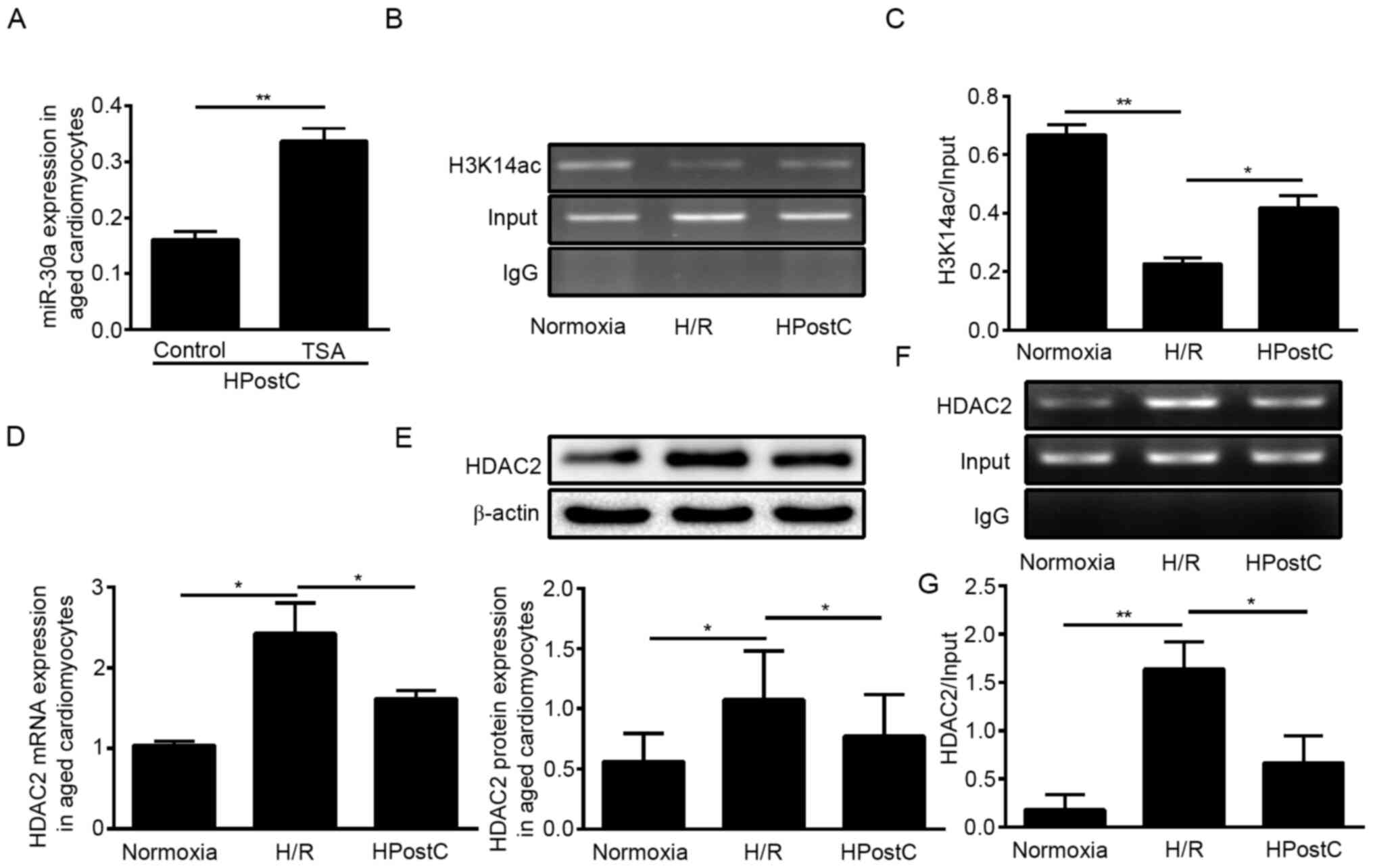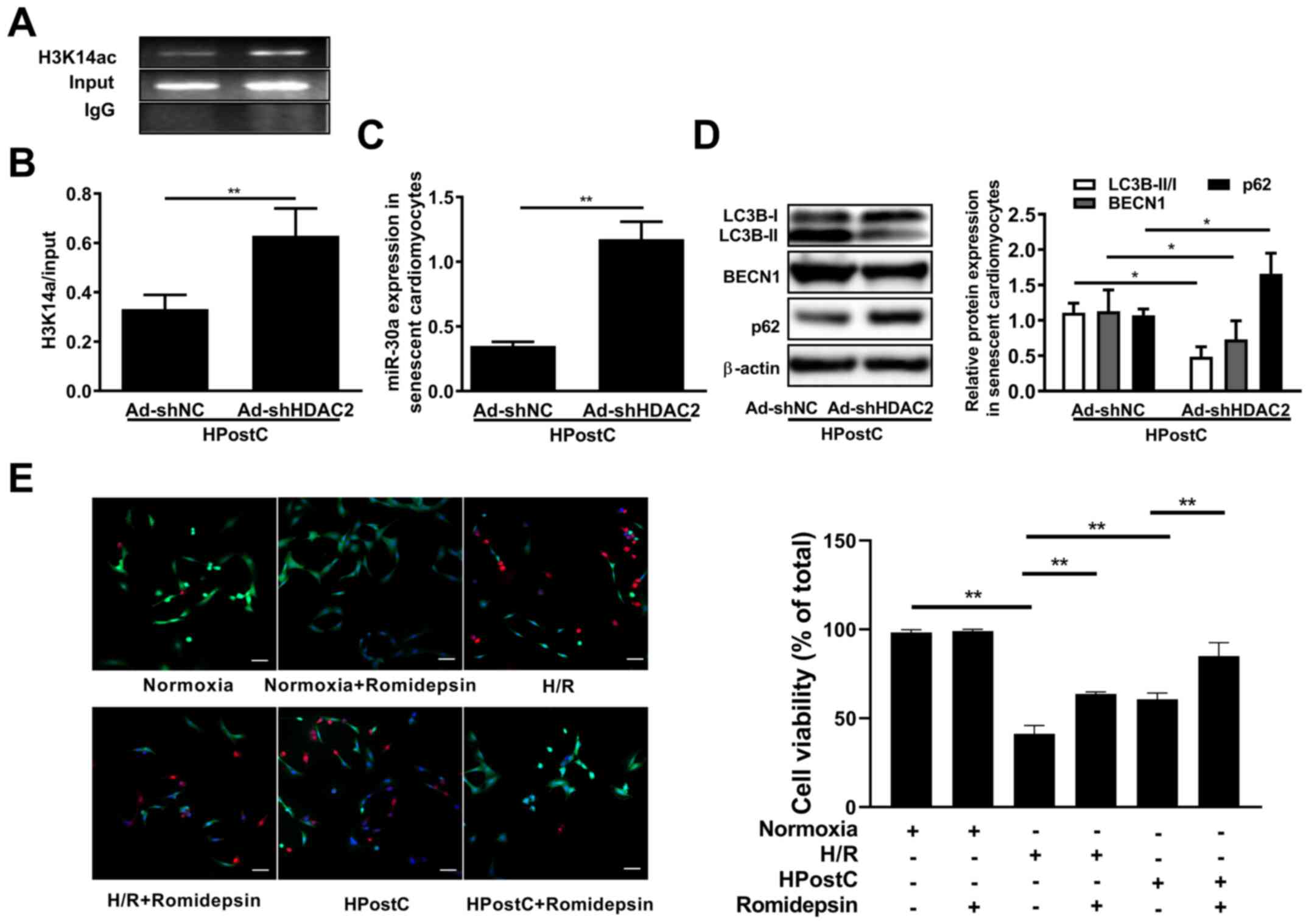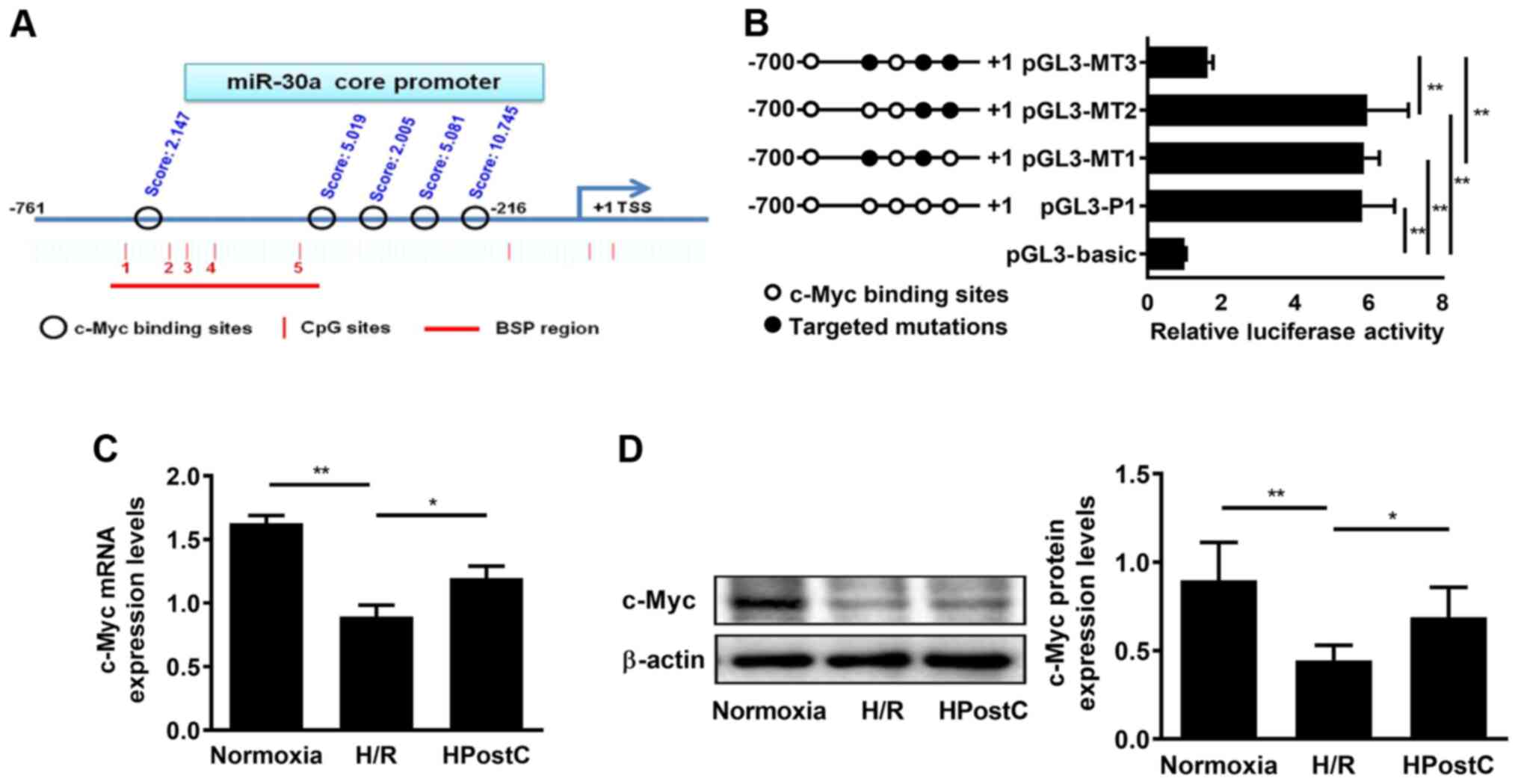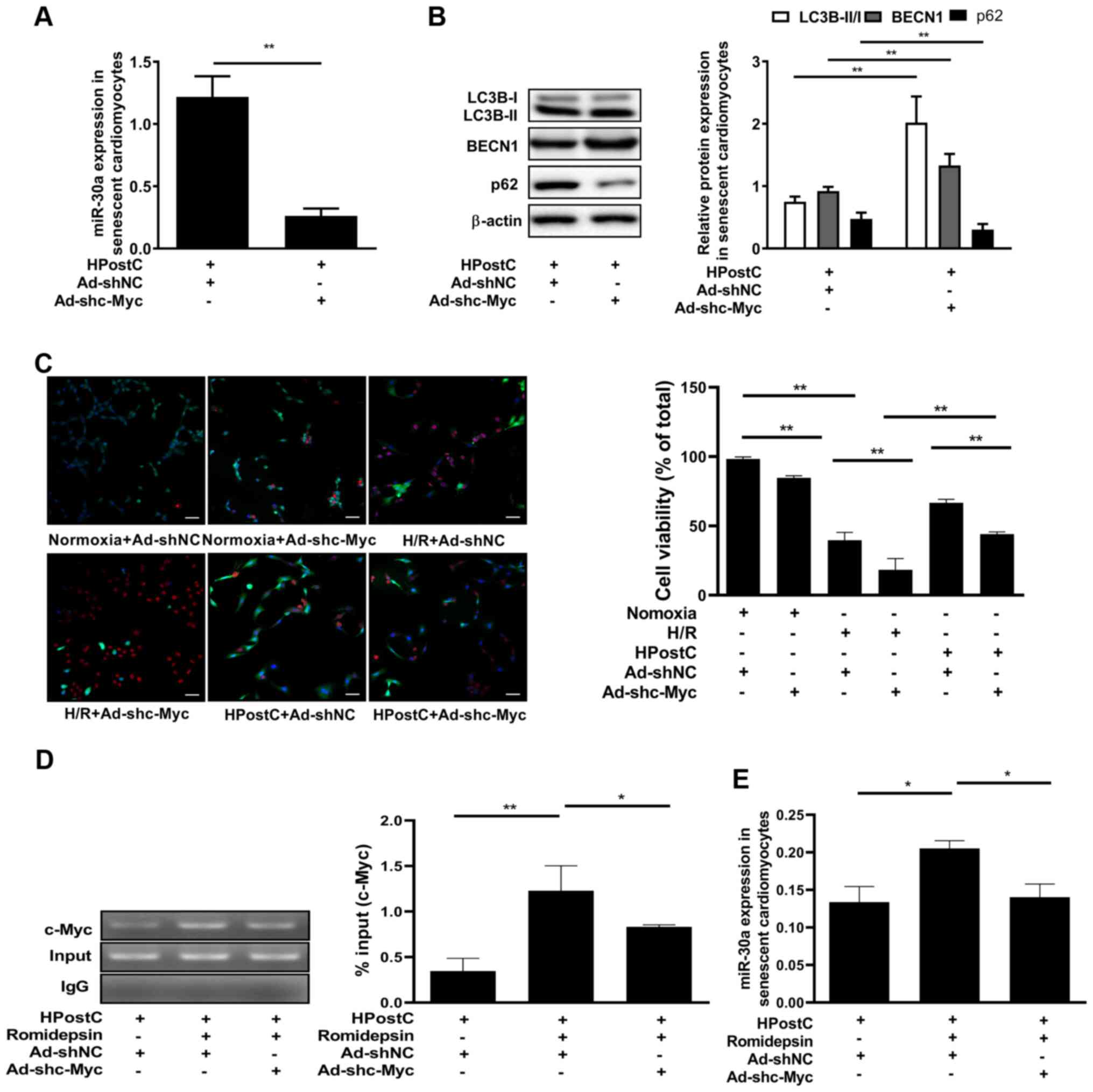|
1
|
Curran J, Burkhoff D and Kloner RA: Beyond
reperfusion: Acute ventricular unloading and cardioprotection
during myocardial infarction. J Cardiovasc Transl Res. 12:95–106.
2019. View Article : Google Scholar : PubMed/NCBI
|
|
2
|
Akhmedov A, Montecucco F, Costantino S,
Vdovenko D, Schaub Clerigué A, Gaul DS, Burger F, Roth A, Carbone
F, Liberale L, et al: Cardiomyocyte-specific JunD overexpression
increases infarct size following ischemia/reperfusion cardiac
injury by downregulating Sirt3. Thromb Haemost. 120:168–180. 2020.
View Article : Google Scholar : PubMed/NCBI
|
|
3
|
Zhang YM, Zhang ZY and Wang RX: Protective
mechanisms of quercetin against myocardial ischemia reperfusion
injury. Front Physiol. 11:9562020. View Article : Google Scholar : PubMed/NCBI
|
|
4
|
Zhao R, Xie E, Yang X and Gong B: Alliin
alleviates myocardial ischemia-reperfusion injury by promoting
autophagy. Biochem Biophys Res Commun. 512:236–243. 2019.
View Article : Google Scholar : PubMed/NCBI
|
|
5
|
Zhang XY, Huang Z, Li QJ, Zhong GQ, Meng
JJ, Wang DX and Tu RH: Ischemic postconditioning attenuates the
inflammatory response in ischemia/reperfusion myocardium by
upregulating miR-499 and inhibiting TLR2 activation. Mol Med Rep.
22:209–218. 2020. View Article : Google Scholar : PubMed/NCBI
|
|
6
|
Wei L, Liang H, Mo M, Liu Z, Ye R, Ye H,
Ouyang W, Yu W, Zhao W and Zhang X: The effect of remote ischemic
postconditioning on autonomic function in patients with acute
ischemic stroke: A randomized controlled trail. Complement Ther
Med. 54:1025412020. View Article : Google Scholar : PubMed/NCBI
|
|
7
|
Zhang C, Liao P, Liang R, Zheng X and Jian
J: Epigallocatechin gallate prevents mitochondrial impairment and
cell apoptosis by regulating miR-30a/p53 axis. Phytomedicine.
61:1528452019. View Article : Google Scholar : PubMed/NCBI
|
|
8
|
Wang Y, Hao Y, Zhang H, Xu L, Ding N, Wang
R, Zhu G, Ma S, Yang A, Yang Y, et al: DNA Hypomethylation of
miR-30a mediated the protection of hypoxia postconditioning against
aged cardiomyocytes hypoxia/reoxygenation injury through inhibiting
autophagy. Circ J. 84:616–625. 2020. View Article : Google Scholar : PubMed/NCBI
|
|
9
|
Kao SH, Cheng WC, Wang YT, Wu HT, Yeh HY,
Chen YJ, Tsai MH and Wu KJ: Regulation of miRNA biogenesis and
histone modification by K63-polyubiquitinated DDX17 controls cancer
stem-like features. Cancer Res. 79:2549–2563. 2019.PubMed/NCBI
|
|
10
|
Rymen B, Kawamura A, Lambolez A, Inagaki
S, Takebayashi A, Iwase A, Sakamoto Y, Sako K, Favero DS, Ikeuchi
M, et al: Histone acetylation orchestrates wound-induced
transcriptional activation and cellular reprogramming in
Arabidopsis. Commun Biol. 2:4042019. View Article : Google Scholar : PubMed/NCBI
|
|
11
|
Wei F, Tang D, Li Z, Kashif MH, Khan A, Lu
H, Jia R and Chen P: Molecular cloning and subcellular localization
of six HDACs and their roles in response to salt and drought stress
in kenaf (Hibiscus cannabinus L.). Biol Res. 52:202019. View Article : Google Scholar : PubMed/NCBI
|
|
12
|
Yuan H, Li H, Yu P, Fan Q, Zhang X, Huang
W, Shen J, Cui Y and Zhou W: Involvement of HDAC6 in ischaemia and
reperfusion-induced rat retinal injury. BMC Ophthalmol. 18:3002018.
View Article : Google Scholar : PubMed/NCBI
|
|
13
|
Zhao TC, Cheng G, Zhang LX, Tseng YT and
Padbury JF: Inhibition of histone deacetylases triggers
pharmacologic preconditioning effects against myocardial ischemic
injury. Cardiovasc Res. 76:473–481. 2007. View Article : Google Scholar : PubMed/NCBI
|
|
14
|
Wang Y, Liu H, Liu X, Zhang X, Wu J, Yuan
L, Du X, Wang R, Ma Y, Chen X, et al: Histone acetylation plays an
important role in MC-LR-induced apoptosis and cycle disorder in SD
rat testicular cells. Chemosphere. 241:1250732020. View Article : Google Scholar : PubMed/NCBI
|
|
15
|
Parrot C, Kurbegovic A, Yao G, Couillard
M, Côté O and Trudel M: c-Myc is a regulator of the PKD1 gene and
PC1-induced pathogenesis. Hum Mol Genet. 28:751–763. 2019.
View Article : Google Scholar : PubMed/NCBI
|
|
16
|
Karagiannis P, Takahashi K, Saito M,
Yoshida Y, Okita K, Watanabe A, Inoue H, Yamashita JK, Todani M,
Nakagawa M, et al: Induced pluripotent stem cells and their use in
human models of disease and development. Physiol Rev. 99:79–114.
2019. View Article : Google Scholar : PubMed/NCBI
|
|
17
|
Saravia J, Zeng H, Dhungana Y, Bastardo
Blanco D, Nguyen TM, Chapman NM, Wang Y, Kanneganti A, Liu S,
Raynor JL, et al: Homeostasis and transitional activation of
regulatory T cells require c-Myc. Sci Adv. 6:eaaw64432020.
View Article : Google Scholar : PubMed/NCBI
|
|
18
|
Zhang L, Fu Y and Guo H: c-Myc-induced
long non-coding RNA small nucleolar RNA host gene 7 regulates
glycolysis in breast cancer. J Breast Cancer. 22:533–547. 2019.
View Article : Google Scholar : PubMed/NCBI
|
|
19
|
Lee EJ, Seo E, Kim JW, Nam SA, Lee JY, Jun
J, Oh S, Park M, Jho EH, Yoo KH, et al: TAZ/Wnt-β-catenin/c-MYC
axis regulates cystogenesis in polycystic kidney disease. Proc Natl
Acad Sci USA. 117:29001–29012. 2020. View Article : Google Scholar : PubMed/NCBI
|
|
20
|
Chen S, Bu D, Ma Y, Zhu J, Chen G, Sun L,
Zuo S, Li T, Pan Y, Wang X, et al: H19 overexpression induces
resistance to 1,25(OH)2D3 by targeting VDR through miR-675-5p in
colon cancer cells. Neoplasia. 19:226–236. 2017. View Article : Google Scholar : PubMed/NCBI
|
|
21
|
Guo W, Zhang H, Yang A, Ma P, Sun L, Deng
M, Mao C, Xiong J, Sun J, Wang N, et al: Homocysteine accelerates
atherosclerosis by inhibiting scavenger receptor class B member1
via DNMT3b/SP1 pathway. J Mol Cell Cardiol. 138:34–48. 2020.
View Article : Google Scholar : PubMed/NCBI
|
|
22
|
UniProt C: UniProt: the universal protein
knowledgebase in 2021. Nucleic Acids Res. 49:D480–D489. 2021.
View Article : Google Scholar : PubMed/NCBI
|
|
23
|
Wen Z, Lian L, Ding H, Hu Y, Xiao Z, Xiong
K and Yang Q: LncRNA ANCR promotes hepatocellular carcinoma
metastasis through upregulating HNRNPA1 expression. RNA Biol.
17:381–394. 2020. View Article : Google Scholar : PubMed/NCBI
|
|
24
|
Chen K, Miller EJ and Sadeghi MM:
PET-based imaging of ischemic heart disease. PET Clin. 14:211–221.
2019. View Article : Google Scholar : PubMed/NCBI
|
|
25
|
Li C, Mu N, Gu C, Liu M, Yang Z, Yin Y,
Chen M, Wang Y, Han Y, Yu L and Ma H: Metformin mediates
cardioprotection against aging-induced ischemic necroptosis. Aging
Cell. 19:e130962020. View Article : Google Scholar : PubMed/NCBI
|
|
26
|
Webster I, Salie R, Marais E, Fan WJ,
Maarman G, Huisamen B and Lochner A: Myocardial susceptibility to
ischaemia/reperfusion in obesity: A re-evaluation of the effects of
age. BMC Physiol. 17:32017. View Article : Google Scholar : PubMed/NCBI
|
|
27
|
Griecsová L, Farkašová V, Gáblovský I,
Khandelwal VK, Bernátová I, Tatarková Z, Kaplan P and Ravingerová
T: Effect of maturation on the resistance of rat hearts against
ischemia. Study of potential molecular mechanisms. Physiol Res. 64
(Suppl):S685–S696. 2015. View Article : Google Scholar
|
|
28
|
O'Brien JD, Ferguson JH and Howlett SE:
Effects of ischemia and reperfusion on isolated ventricular
myocytes from young adult and aged Fischer 344 rat hearts. Am J
Physiol Heart Circ Physiol. 294:H2174–H1783. 2008. View Article : Google Scholar
|
|
29
|
Bayrami G, Karimi P, Agha-Hosseini F,
Feyzizadeh S and Badalzadeh R: Effect of ischemic postconditioning
on myocardial function and infarct size following reperfusion
injury in diabetic rats pretreated with vildagliptin. J Cardiovasc
Pharmacol Ther. 23:174–183. 2018. View Article : Google Scholar : PubMed/NCBI
|
|
30
|
Chávez MN, Morales RA, López-Crisosto C,
Roa JC, Allende ML and Lavandero S: Autophagy activation in
zebrafish heart regeneration. Sci Rep. 10:21912020. View Article : Google Scholar
|
|
31
|
Shi B, Ma M, Zheng Y, Pan Y and Lin X:
mTOR and Beclin1: Two key autophagy-related molecules and their
roles in myocardial ischemia/reperfusion injury. J Cell Physiol.
234:12562–12568. 2019. View Article : Google Scholar : PubMed/NCBI
|
|
32
|
Torres-Esquivel C, Montiel T,
Flores-Méndez M and Massieu L: Effect of β-hydroxybutyrate on
autophagy dynamics during severe hypoglycemia and the hypoglycemic
coma. Front Cell Neurosci. 14:5472152020. View Article : Google Scholar : PubMed/NCBI
|
|
33
|
Chen C, Li J, Zhang W, Shah SWA and Ishfaq
M: Mycoplasma gallisepticum triggers immune damage in the chicken
thymus by activating the TLR-2/MyD88/NF-κB signaling pathway and
NLRP3 inflammasome. Vet Res. 51:522020. View Article : Google Scholar : PubMed/NCBI
|
|
34
|
Huang Y, Liao Y, Zhang H and Li S: Lead
exposure induces cell autophagy via blocking the Akt/mTOR signaling
in rat astrocytes. J Toxicol Sci. 45:559–567. 2020. View Article : Google Scholar : PubMed/NCBI
|
|
35
|
Liu Y, Song A, Wu H, Sun Y and Dai M:
Paeonol inhibits apoptosis of vascular smooth muscle cells via
up-regulation of autophagy by activating class III PI3K/Beclin-1
signaling pathway. Life Sci. 264:1187142021. View Article : Google Scholar : PubMed/NCBI
|
|
36
|
Campbell GR, Bruckman RS, Chu YL, Trout RN
and Spector SA: SMAC mimetics induce autophagy-dependent apoptosis
of HIV-1-infected resting memory CD4+ T cells. Cell Host Microbe.
24:689–702.e7. 2018. View Article : Google Scholar : PubMed/NCBI
|
|
37
|
Zhang J, Zhang X, Cui Y, Ferdous M, Cui L
and Zhao P: Different postconditioning cycles affect prognosis of
aged patients undergoing primary percutaneous coronary
intervention. Cardiol J. 25:666–673. 2018.PubMed/NCBI
|
|
38
|
Slettom G, Jonassen AK, Dahle GO, Seifert
R, Larsen TH, Berge RK and Nordrehaug JE: Insulin postconditioning
reduces infarct size in the porcine heart in a dose-dependent
manner. J Cardiovasc Pharmacol Ther. 22:179–188. 2017. View Article : Google Scholar : PubMed/NCBI
|
|
39
|
Maciejak A, Kostarska-Srokosz E, Gierlak
W, Dluzniewski M, Kuch M, Marchel M, Opolski G, Kiliszek M, Matlak
K, Dobrzycki S, et al: Circulating miR-30a-5p as a prognostic
biomarker of left ventricular dysfunction after acute myocardial
infarction. Sci Rep. 8:98832018. View Article : Google Scholar : PubMed/NCBI
|
|
40
|
Lv XB, Niu QH, Zhang M, Feng L and Feng J:
Critical functions of microRNA-30a-5p-E2F3 in cardiomyocyte
apoptosis induced by hypoxia/reoxygenation. Kaohsiung J Med Sci.
37:92–100. 2021. View Article : Google Scholar : PubMed/NCBI
|
|
41
|
Ding H, Wang Y, Hu L, Xue S, Wang Y, Zhang
L, Zhang Y, Qi H, Yu H, Aung LHH, et al: Combined detection of
miR-21-5p, miR-30a-3p, miR-30a-5p, miR-155-5p, miR-216a and miR-217
for screening of early heart failure diseases. Biosci Rep.
40:BSR201916532020. View Article : Google Scholar : PubMed/NCBI
|
|
42
|
Zhao DS, Chen Y, Jiang H, Lu JP, Zhang G,
Geng J, Zhang Q, Shen JH, Zhou X, Zhu W and Shan QJ: Serum miR-210
and miR-30a expressions tend to revert to fetal levels in Chinese
adult patients with chronic heart failure. Cardiovasc Pathol.
22:444–450. 2013. View Article : Google Scholar : PubMed/NCBI
|
|
43
|
Li D, Wang J, Hou J, Fu J, Liu J and Lin
R: Salvianolic acid B induced upregulation of miR-30a protects
cardiac myocytes from ischemia/reperfusion injury. BMC Complement
Altern Med. 16:3362016. View Article : Google Scholar : PubMed/NCBI
|
|
44
|
Shen Y, Shen Z, Miao L, Xin X, Lin S, Zhu
Y, Guo W and Zhu YZ: miRNA-30 family inhibition protects against
cardiac ischemic injury by regulating cystathionine-γ-lyase
expression. Antioxid Redox Signal. 22:224–240. 2015. View Article : Google Scholar : PubMed/NCBI
|
|
45
|
Long G, Wang F, Duan Q, Yang S, Chen F,
Gong W, Yang X, Wang Y, Chen C and Wang DW: Circulating miR-30a,
miR-195 and let-7b associated with acute myocardial infarction.
PLoS One. 7:e509262012. View Article : Google Scholar : PubMed/NCBI
|
|
46
|
Kubiak M, Jurek A, Kamińska K, Kowalewski
J, Huang S and Lewandowska MA: Chromosome conformation capture
reveals two elements that interact with the PTBP3 (ROD1)
transcription start site. Int J Mol Sci. 20:2422019. View Article : Google Scholar : PubMed/NCBI
|
|
47
|
Lee J and Lee TH: How protein binding
sensitizes the nucleosome to histone H3K56 acetylation. ACS Chem
Biol. 14:506–515. 2019. View Article : Google Scholar : PubMed/NCBI
|
|
48
|
Hu Y, Lai Y, Chen X, Zhou DX and Zhao Y:
Distribution pattern of histone marks potentially determines their
roles in transcription and RNA processing in rice. J Plant Physiol.
249:1531672020. View Article : Google Scholar : PubMed/NCBI
|
|
49
|
Narita T, Weinert BT and Choudhary C:
Functions and mechanisms of non-histone protein acetylation. Nature
reviews. Mol Cell Biol. 20:156–174. 2019.PubMed/NCBI
|
|
50
|
Okonkwo A, Mitra J, Johnson GS, Li L,
Dashwood WM, Hegde ML, Yue C, Dashwood RH and Rajendran P:
Heterocyclic analogs of sulforaphane trigger DNA damage and impede
DNA repair in colon cancer cells: Interplay of HATs and HDACs. Mol
Nutr Food Res. 62:e18002282018. View Article : Google Scholar : PubMed/NCBI
|
|
51
|
Han KA, Shin WH, Jung S, Seol W, Seo H, Ko
C and Chung KC: Leucine-rich repeat kinase 2 exacerbates neuronal
cytotoxicity through phosphorylation of histone deacetylase 3 and
histone deacetylation. Hum Mol Genet. 26:1–18. 2017.PubMed/NCBI
|
|
52
|
Bascom GD and Schlick T: Chromatin fiber
folding directed by cooperative histone tail acetylation and linker
histone binding. Biophys J. 114:2376–2385. 2018. View Article : Google Scholar : PubMed/NCBI
|
|
53
|
Church M, Smith KC, Alhussain MM, Pennings
S and Fleming AB: Sas3 and Ada2(Gcn5)-dependent histone H3
acetylation is required for transcription elongation at the
de-repressed FLO1 gene. Nucleic Acids Res. 45:4413–4430.
2017.PubMed/NCBI
|
|
54
|
Zhang BL, Guo TW, Gao LL, Ji GQ, Gu XH,
Shao YQ, Yao RQ and Gao DS: Egr-1 and RNA POL II facilitate glioma
cell GDNF transcription induced by histone hyperacetylation in
promoter II. Oncotarget. 8:45105–45116. 2017. View Article : Google Scholar : PubMed/NCBI
|


















